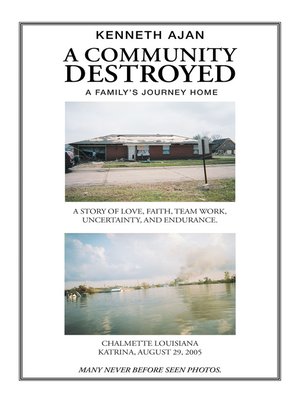
Sign up to save your library
With an OverDrive account, you can save your favorite libraries for at-a-glance information about availability. Find out more about OverDrive accounts.
Find this title in Libby, the library reading app by OverDrive.



Search for a digital library with this title
Title found at these libraries:
| Library Name | Distance |
|---|---|
| Loading... |
The morning of August 27 was like most mornings in August: very hot and humid. The residents of Saint Bernard Parish were taking care of their everyday business. The streets of our small community were filled with cars and trucks. However, on this day, there was a new concern in the minds of the people. As with every summer, it was the height of hurricane season; the months of August and September were usually very active. The local news channels had posted a hurricane warning for Louisiana and the neighboring states. I was working offshore on an oil production platform for BP. They were monitoring the situation also. I called home and asked my wife to fill the SUV with gas. This was part of our action plan when a storm was in the gulf. My wife told me she had to wait one hour before she was able to fuel up because of the long line at the pump. The Saint Bernard local government had begun their evacuation plans for the parish. BP also decided to evacuate all personnel from there platforms in the affected areas. There were many things that had to be done to prepare a production platform for an evacuation. The field I was working in had over twenty-five platforms. They quickly sent all the operators out to the platforms to tie down loose objects, close all block valves to shut down the production of the wells, and isolate any piece of production equipment that could be a threat to the environment. After a long day, it was finally time to board the boat for home. I had about a two in a half-hour drive to reach my home in Chalmette. However, there was a lot of traffic as people were beginning to evacuate their homes. The local news channel said that it was about thirty-six hours before Katrina would make landfall. The New Orleans officials were going to begin contraflow to ease the traffic during the evacuation process. What this involved was reversing the direction of lanes on several main roadways, making all the lanes flow out of the city. They were going to begin contraflow at 4 p.m. that evening. I still had an hour's drive time before reaching the parish. The possibility of getting caught up in gridlock was beginning to cross my mind. This would be a serious problem because I had many things to do to prepare for the storm. In any case, I finally made it home. I looked at the news that afternoon. Katrina's winds were about 118 miles per hour. The city parishes had issued a mandatory evacuation for all low-lying areas. Many people had begun to exit the city. I began to be complacent about evacuating. This was because the winds did not seem to be that bad, and for the past two summers, I evacuated for storms only to find everything as I left it when I returned. So the end result was I had gone on this long and tiring drive for nothing. On into the night of August 27, the more I thought about leaving, the more I just wanted to stay home. That afternoon, I had my son bring me to home depot to pick up some tin to cover my windows. By this time, it was getting late, so my wife and I turned in for the night.







